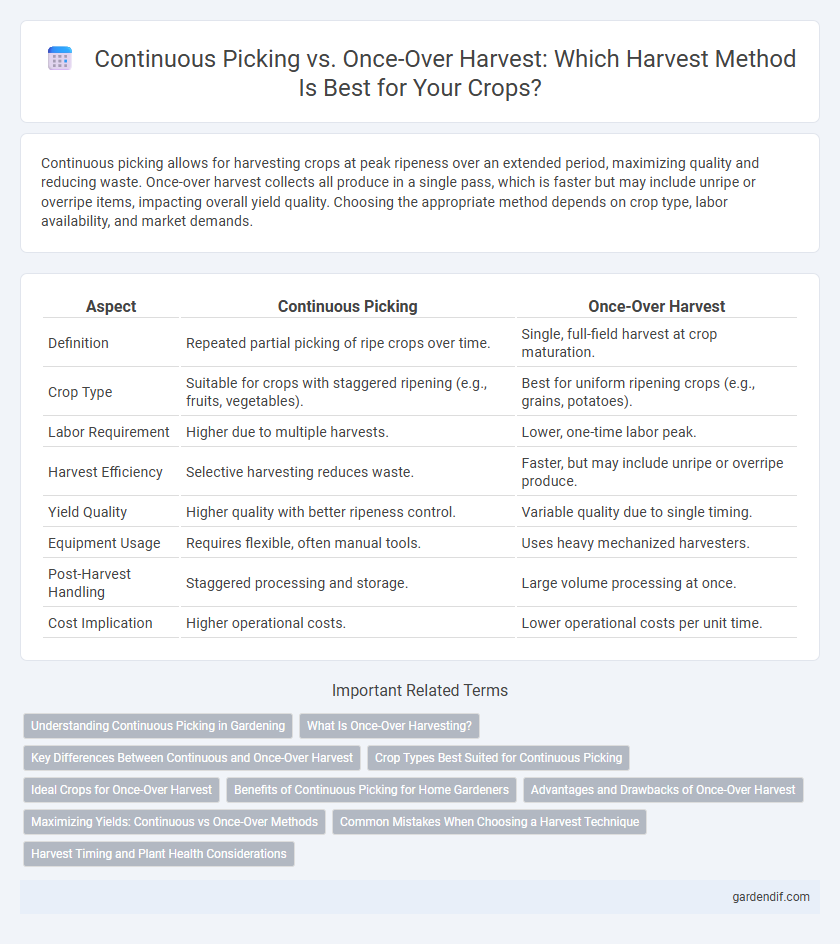
Continuous Picking vs Once-Over Harvest Illustration
Continuous picking allows for harvesting crops at peak ripeness over an extended period, maximizing quality and reducing waste. Once-over harvest collects all produce in a single pass, which is faster but may include unripe or overripe items, impacting overall yield quality. Choosing the appropriate method depends on crop type, labor availability, and market demands.
Table of Comparison
| Aspect | Continuous Picking | Once-Over Harvest |
|---|---|---|
| Definition | Repeated partial picking of ripe crops over time. | Single, full-field harvest at crop maturation. |
| Crop Type | Suitable for crops with staggered ripening (e.g., fruits, vegetables). | Best for uniform ripening crops (e.g., grains, potatoes). |
| Labor Requirement | Higher due to multiple harvests. | Lower, one-time labor peak. |
| Harvest Efficiency | Selective harvesting reduces waste. | Faster, but may include unripe or overripe produce. |
| Yield Quality | Higher quality with better ripeness control. | Variable quality due to single timing. |
| Equipment Usage | Requires flexible, often manual tools. | Uses heavy mechanized harvesters. |
| Post-Harvest Handling | Staggered processing and storage. | Large volume processing at once. |
| Cost Implication | Higher operational costs. | Lower operational costs per unit time. |
Understanding Continuous Picking in Gardening
Continuous picking in gardening involves harvesting fruits and vegetables incrementally as they ripen, promoting sustained plant productivity and minimizing waste. This method allows gardeners to manage crop cycles efficiently by harvesting only mature produce, which can enhance flavor and extend shelf life. Unlike once-over harvests that collect all produce simultaneously, continuous picking maximizes yield and supports ongoing plant health through regular maintenance.
What Is Once-Over Harvesting?
Once-over harvesting refers to a method where all crops in a field are harvested at a single time, regardless of varying maturity levels. This approach maximizes operational efficiency by reducing labor and equipment use, but may sacrifice optimal crop quality or yield uniformity. It contrasts with continuous picking, which involves multiple passes, selecting only ripe produce, enhancing quality but increasing time and costs.
Key Differences Between Continuous and Once-Over Harvest
Continuous picking involves repeated harvesting of crops over a series of days, allowing for selective removal of ripe produce while preserving unripe fruits for future harvests. Once-over harvest collects the entire crop in a single operation, maximizing efficiency but risking inclusion of immature or overripe items. Key differences include labor intensity, crop maturity management, and impact on overall yield quality and timing.
Crop Types Best Suited for Continuous Picking
Leafy greens, berries, and vine crops are best suited for continuous picking due to their growth patterns and harvesting requirements, allowing for multiple harvests over a growing season. This method minimizes crop damage and maximizes yield by selectively picking ripe portions while leaving the rest to mature. Continuous picking is less effective for root vegetables and grains, which are typically harvested once-over when fully matured.
Ideal Crops for Once-Over Harvest
Once-over harvest is ideal for crops such as wheat, corn, and soybeans that mature uniformly and can be efficiently collected in a single pass using combines or mechanical harvesters. This method minimizes labor costs and reduces the time between maturity and collection, which is crucial for preventing crop loss and maintaining quality. Crops with synchronized ripening and less susceptibility to damage during mechanical harvest are best suited for this intensive harvesting approach.
Benefits of Continuous Picking for Home Gardeners
Continuous picking maximizes fruit and vegetable yields by allowing gardeners to harvest produce at peak ripeness, which enhances flavor and nutritional value. This method reduces waste and encourages consistent plant growth by preventing overripe produce from attracting pests or diseases. Home gardeners benefit from extended harvest periods and improved garden productivity, making continuous picking ideal for small-scale, sustainable cultivation.
Advantages and Drawbacks of Once-Over Harvest
Once-Over Harvest offers the advantage of reduced labor costs and faster harvesting since crops are collected in a single pass, minimizing field traffic and soil compaction. However, this method often results in lower crop quality and increased losses because fruits or vegetables are harvested at varying ripeness levels, leading to uneven product consistency. Farmers must balance efficiency with product quality when choosing Once-Over Harvest, as it can impact market value and post-harvest storage life.
Maximizing Yields: Continuous vs Once-Over Methods
Continuous picking allows for multiple harvests throughout the growing season, ensuring fruits and vegetables are harvested at peak ripeness, which maximizes yield quality and reduces waste. Once-over harvest involves collecting all produce in a single pass, which can expedite operations but may miss optimally ripe crops and increase post-harvest losses. Choosing between continuous picking and once-over methods depends on crop type, labor availability, and market demand, each influencing overall yield efficiency.
Common Mistakes When Choosing a Harvest Technique
Choosing between continuous picking and once-over harvest often leads to common mistakes such as overlooking crop maturity variability, which causes uneven quality and yield loss. Ignoring labor availability and costs can result in inefficiencies, as continuous picking requires more frequent labor input compared to once-over harvest. Misjudging the crop's susceptibility to damage during harvest also affects post-harvest quality, as once-over harvest may increase bruising in delicate crops.
Harvest Timing and Plant Health Considerations
Continuous picking allows for selective harvesting based on optimal ripeness, enhancing fruit quality and reducing plant stress by minimizing damage during each harvest session. Once-over harvest ensures a single, efficient collection ideal for crops with uniform ripening but may increase plant stress and risk of fruit damage due to bulk handling. Timing in continuous picking aligns with peak quality windows, while once-over harvesting prioritizes labor efficiency and market deadlines over staggered ripeness.
Continuous Picking vs Once-Over Harvest Infographic

 gardendif.com
gardendif.com